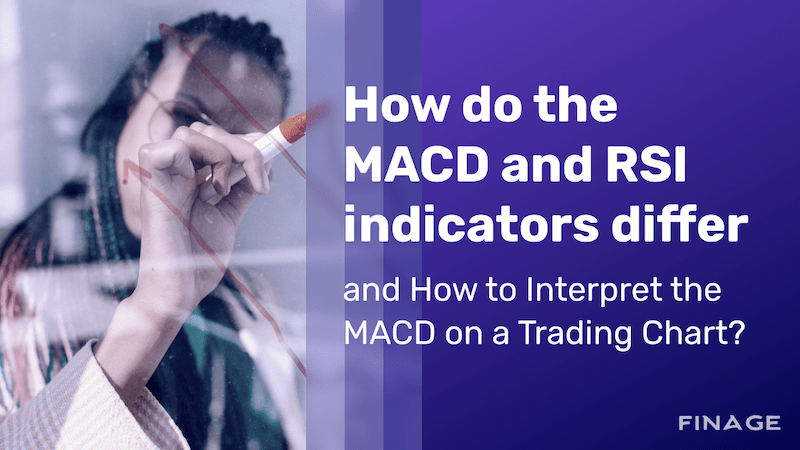How MACD & RSI Indicators Differ and Ways to Interpret the MACD on a Trading Chart
5 min read • December 16, 2021

Introduction
Among the many momentum indicators used by technical analysts, only two stand out from the pack: MACD and RSI. Technical analysts and traders prefer to use these above the rest for the mere reason that they provide the best signals.
MACD (Moving Average Convergence Divergence) and RSI (Relative Strength Index) are similar in that they provide signals to traders. However, they do have some key differences. These differences have a lot to do with what they are designed to measure.
Contents:
MACD Indicator on a Trading Chart
RSI Indicator on a Trading Chart
RSI & MACD: Head to Head
Alternatives to MACD and RSI
- Volume-weighted Average Price (VWAP)
- Simple-moving Average (SMA)
- Bollinger Bands
Final Thoughts
MACD Indicator on a Trading Chart
Typically used to figure out the strength of the stock price movement, MACD is a favourite of day traders. It achieves its purpose through the measuring of divergence of two EMAs (Exponential moving averages). This usually occurs at a 12 or 26-period EMA.
If you subtract the 26-period EMA from a 12-period EMA, you can come up with a MACD line. A line will then show a nine-period EMA that will reveal the calculation in the form of a histogram. This histogram conveys the basic representation of the MACD.
A zero line will then be used to provide negative and positive values for the MACD. This gauge will show the market momentum. Basically, an increase in separation between the 12 and 26- period EMAs shows increased market momentum in either way.
RSI Indicator on a Trading Chart
The goal of the Relative Strength Index is to reveal whether or not a market is oversold or overbought when in relation to today’s price levels. It is able to make this happen by calculating the average price gains and losses over a period of time.
The values on the RSI scale are plotted on a 0-100 scale. All values above 70 indicate an overbought market relative to price. The opposite is true for values below 30 as they are thought to be oversold. Values below 50 are said to be bearish and those above 50 are considered bullish.
RSI & MACD: Head to Head
In reality, both RSI and MACD are momentum indicators that follow trends while showing the relationship between averages of a security price. What’s next?
With MACD, the calculation takes place by subtracting the 26-period EMA from the 12-period EMA. The difference is known as the MACD line. An EMA over 9 days of the MACD is known as the signal line and is plotted on top of the MACD line. This can in turn act as a trigger for buy and sell signals.
It is safe for traders to buy securities if the MACD goes above the signal line. If the MACD is below the signal line, it is probably the right time for a trader to sell the security.
The goal of RSI is to indicate if a market is thought to be oversold or overbought relative to the recent price levels. It calculates average price gains and losses over a period of time which has a default time period of 14 periods. The values of each bond range from 0-100.
The MACD’s measurements are based on the relationship between two EMAs. This differs from the RSI, which measures price change based on the highs and lows of recent prices. Both indicators are usually used in tandem to give analysts more data to use in the market.
MACD and RSI are useful to day traders but are totally different because they measure different factors. For this reason, they may provide contradictory indications. Thus confusing whoever is depending on that data.
An example of this would be if the MACD indicated that the market was still buying momentum and somehow the RSI showed a sustained reading above 70. A sustained reading above 70 would indicate that there is an overextension of the market. This would clash with the MACD’s indicator which shows the aforementioned buying momentum.
This clashing information may cause damages to anyone in the market looking for an edge and using these tools to achieve them. However, these tools are responsive to trends and are often found showing the same upwards or downwards swing.
Alternatives to MACD and RSI
Apart from MACD and RSI, there are a few indicators that are commonly used by day traders, although they don’t have the same notoriety. These indicators can also be used at the same time as MACD and RSI in order to form a complete technical picture. Among the few are three fairly well-known indicators and they are as follows:
1. Volume-weighted Average Price (VWAP)
VWAP is an indicator that is based on volume and price movement. It, like most other indicators, can work together with MACD and RSI. It does this by adding another calculation to confirm insights that either MACD or RSI offers.
2. Simple-moving Average (SMA)
This indicator is mainly forex-based. It can offer additional insights into the price movement of forex and its likelihood to change.
3. Bollinger Bands
This is used when price reversal has been anticipated. If this is the case, it is wise to figure out whether the price is approaching a particular band. When traders are expected to open and close positions based on certain levels.
Final Thoughts
If a Forex analyst strategy is tested and refined, it is most likely to combine MACD and RSI to form a trading strategy that is exponentially more complex. However, the decision to use either or both is up to traders. Additionally, before using MACD or RSI to confirm your trades, think for a second if these two indicators are enough to make the decision.
You can get market data feeds with Indicators in Finage.
Build with us today!
Claim Your Free API Key Today
Access stock, forex and crypto market data with a free API key—no credit card required.

Stay Informed, Stay Ahead
Finage Blog: Data-Driven Insights & Ideas
Discover company news, announcements, updates, guides and more


